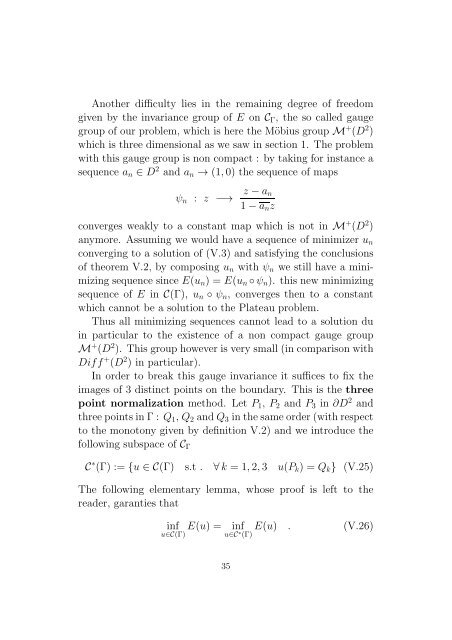Conformally Invariant Variational Problems. - SAM
Conformally Invariant Variational Problems. - SAM
Conformally Invariant Variational Problems. - SAM
You also want an ePaper? Increase the reach of your titles
YUMPU automatically turns print PDFs into web optimized ePapers that Google loves.
Another difficulty lies in the remaining degree of freedom<br />
given by the invariance group of E on C Γ , the so called gauge<br />
group of our problem, which is here the Möbius group M + (D 2 )<br />
which is three dimensional as we saw in section 1. The problem<br />
with this gauge group is non compact : by taking for instance a<br />
sequence a n ∈ D 2 and a n → (1,0) the sequence of maps<br />
ψ n : z −→ z −a n<br />
1−a n z<br />
converges weakly to a constant map which is not in M + (D 2 )<br />
anymore. Assuming we would have a sequence of minimizer u n<br />
converging to a solution of (V.3) and satisfying the conclusions<br />
of theorem V.2, by composing u n with ψ n we still have a minimizing<br />
sequence since E(u n ) = E(u n ◦ψ n ). this new minimizing<br />
sequence of E in C(Γ), u n ◦ ψ n , converges then to a constant<br />
which cannot be a solution to the Plateau problem.<br />
Thus all minimizing sequences cannot lead to a solution du<br />
in particular to the existence of a non compact gauge group<br />
M + (D 2 ). This group however is very small (in comparison with<br />
Diff + (D 2 ) in particular).<br />
In order to break this gauge invariance it suffices to fix the<br />
images of 3 distinct points on the boundary. This is the three<br />
point normalization method. Let P 1 , P 2 and P 3 in ∂D 2 and<br />
threepointsinΓ: Q 1 , Q 2 andQ 3 inthesameorder(withrespect<br />
to the monotony given by definition V.2) and we introduce the<br />
following subspace of C Γ<br />
C ∗ (Γ) := {u ∈ C(Γ) s.t . ∀k = 1,2,3 u(P k ) = Q k } (V.25)<br />
The following elementary lemma, whose proof is left to the<br />
reader, garanties that<br />
inf E(u) = inf E(u) .<br />
u∈C(Γ) u∈C ∗ (Γ)<br />
(V.26)<br />
35
















